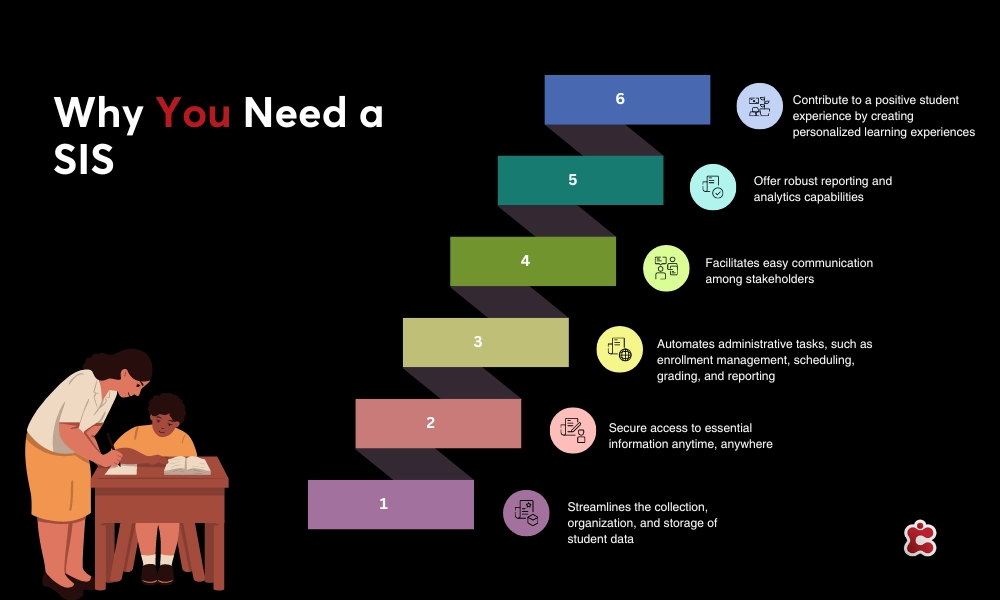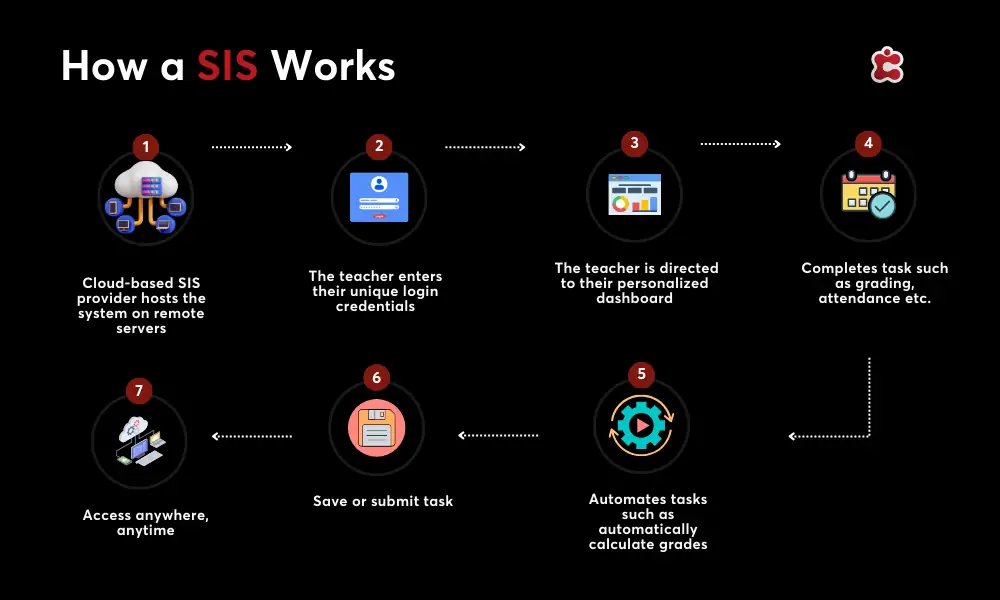We live in an automated world. From shopping online to managing finances, automation touches every aspect of our lives. Yet, amidst this technological revolution, educational institutions still grapple with the complexities of manual administrative tasks.
The administrative workload within these institutions can often become daunting, leaving educators and support staff feeling overwhelmed. Whether it is maintaining student records, organizing schedules, or managing enrollments, the administrative burden can be relentless.
Imagine having a system that can reduce the time spent on admin tasks by 90% or improve teacher grading time by 60%. Student Information Systems (SIS) offers this potential game-changer. However, despite their ability to enhance efficiency, many institutions fail to fully utilize these systems.
This article serves as a comprehensive guide to understanding how Student Information Systems work, with the aim of helping your institution maximize the system’s potential.

1. Initial Data Input Process on Student Information Systems
The data collection process involves gathering essential details about students, including personal information, enrollment status, academic records, and contact information. This information serves as the foundation upon which the entire student profile within the system is built. Additionally, data regarding courses offered, class schedules, and instructor assignments should also be collected to facilitate academic scheduling.
Once gathered, the necessary data is thoroughly inputted into the software. This entails transferring information from various sources, such as paper forms, digital records, or other databases, into the interfaces of Student Information Systems. Data entry personnel play a crucial role in this phase, ensuring accuracy and completeness during the transfer process.
Attention to detail is critical during data entry to avoid errors that could compromise the integrity of the information stored within the system. Each data field, from student names to course codes, must be carefully inputted to maintain consistency and accuracy. Additionally, validation checks should be implemented to identify and correct any discrepancies in the data. This may involve cross-referencing the inputted data with existing records or conducting verification checks with relevant stakeholders.
2. Using SIS to Organize and Store Data
After gathering and inputting data into the system, organizing and storing it becomes an important step in ensuring its accessibility and security. Databases serve as the backbone of SIS platforms, providing a structured framework for organizing and storing information. These databases are specifically crafted to handle diverse data types. This can include anything from basic student demographics to complex academic records and administrative documents. By categorizing data into distinct fields, databases allow for efficient retrieval and manipulation of information when required.
The advent of cloud-based solutions has improved the way educational institutions handle data storage and management. Cloud computing offers unparalleled scalability, flexibility, and accessibility. This allows institutions to store vast quantities of data securely off-site while providing instant remote access to authorized users. This eliminates the need for costly on-premises infrastructure and alleviates concerns regarding data loss or hardware failure.

3. The Automation of Administrative Tasks
Now is the time when the software shows its truest strengths by simplifying complex tasks with remarkable ease and precision. Enrollment management, known for its heavy reliance on paperwork and manual data entry, undergoes a profound transformation through the automation capabilities of Student Information Systems. These systems introduce intuitive interfaces and adaptable workflows that equip administrators to process student information effortlessly. From admission forms to course selection, each step is automated. Thereby reducing errors and expediting the enrollment process.
Scheduling, another administrative headache, is simplified with the automotive powers that come with Student Information Systems. By analyzing course offerings, student preferences, and resource availability, the software generates schedules that minimize conflicts. Educators can easily access and adjust schedules as needed, ensuring smooth operations and optimal utilization of resources.
Grading is also made more manageable with automation by SIS. By digitizing assignments, the system enables educators to input, calculate, and analyze grades effortlessly. Automated grading features further streamline the process, providing instant feedback to students and reducing administrative burden.
4. Communication Features and Stakeholder Integration
Communication lies at the heart of any successful educational ecosystem. Through integrated portals, stakeholders gain access to a centralized platform. They can now easily retrieve essential information, such as academic progress, attendance records, and upcoming events. Administrators can disseminate important announcements, while teachers can share course materials and assignment deadlines, all within a unified digital space. This consolidation of information promotes transparency and ensures that everyone remains well-informed and up-to-date.
Teachers can communicate with students about assignments or provide timely feedback on their performance. Similarly, parents can communicate with teachers to stay informed about their child’s progress and address any concerns promptly. Student Information Systems enable collaboration among stakeholders, strengthening them to work together towards common goals.
5. Using Student Information Systems for Analysis and Reporting
The logical next step in optimizing educational processes is utilizing the reporting and analytics capabilities within SIS platforms. These capabilities serve as a powerful tool for educational institutions to make data-driven decisions and improve overall outcomes. By utilizing the wealth of data stored within the system, institutions can generate comprehensive reports and analytics. These offer valuable insights into various aspects of the educational journey, such as student performance metrics, attendance trends, and demographic information. Such data analysis enables educators and administrators to gain a deeper understanding of student progress and engagement levels.
The availability of detailed reports and analytics aids in evaluating the effectiveness of educational programs and initiatives. Institutions can track KPIs over time to assess the impact of interventions and make informed decisions regarding resource allocation and program adjustments.
Classter’s Integrated Student Information Systems
In tackling the inefficiencies prevalent in educational institutions, Classter offers integrated Student Information Systems as the ultimate solution. By seamlessly integrating power-packed functionality with a user-friendly experience, efficient school registration management becomes a reality. Access to comprehensive student information, coupled with robust security measures, ensures personalized education while safeguarding sensitive data.
The system’s support for extracurricular activities enhances student engagement and simplifies administration. With Classter, institutions benefit from centralized platforms for organizing diverse activities. Optimized timetables reduce scheduling conflicts, ensuring a smooth year-to-year transfer of academic continuity.
Furthermore, bulk actions and mass reporting features streamline administrative tasks, facilitating informed decision-making. Customizable templates enable personalized communication with stakeholders, while centralized contact management supports organizational efficiency.
FAQ’s
SIS streamlines administrative tasks, reduce manual workload, improve data accuracy, enhance communication among stakeholders, and make data-driven decisions to improve overall outcomes
SIS platforms prioritize data security through robust encryption protocols, access controls, and regular security audits. They comply with relevant data protection regulations to ensure the confidentiality and integrity of student information.
Classter stands out as a leading choice due to its seamless integration of powerful functionality with a user-friendly experience, robust security measures, support for extracurricular activities, centralized platforms, and customizable templates.

